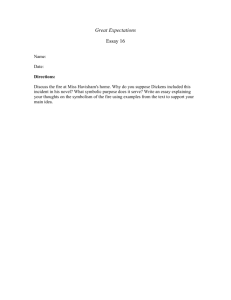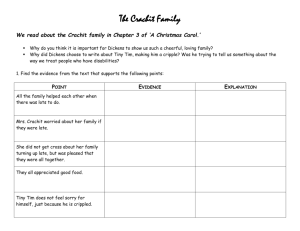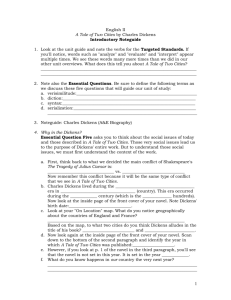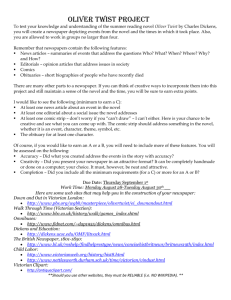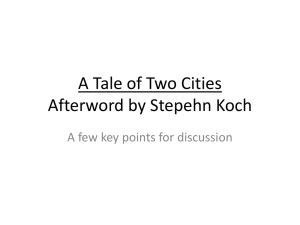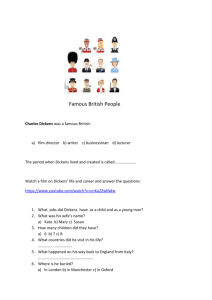1. Compare and contrast the doubles, Charles Darnay and Sydney
advertisement
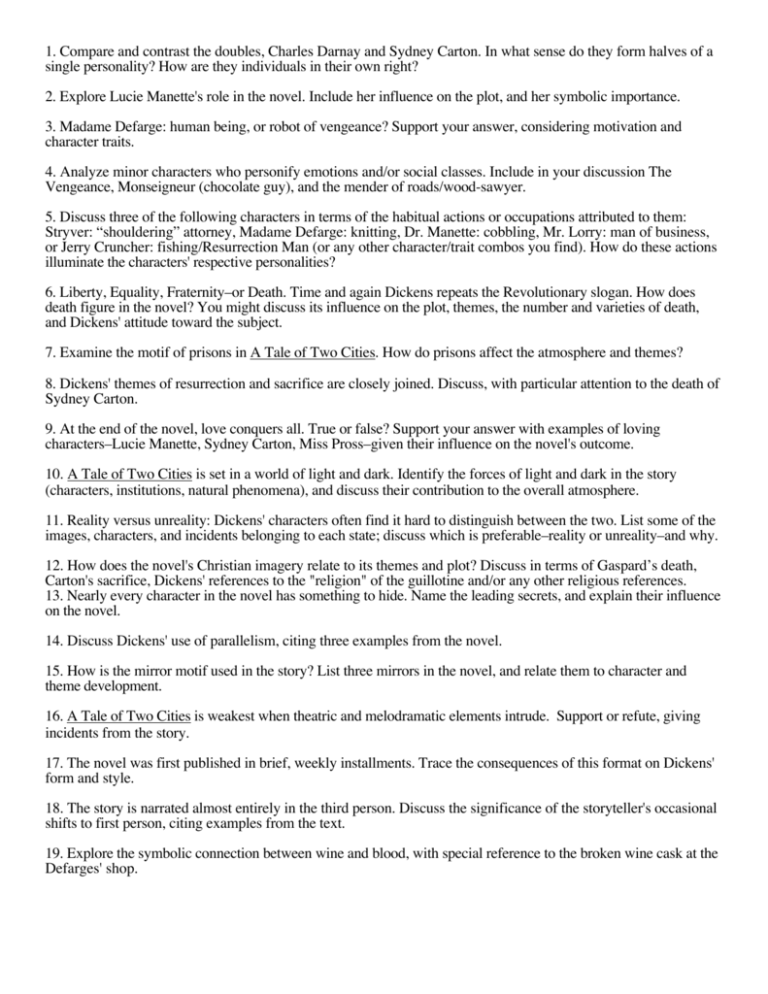
1. Compare and contrast the doubles, Charles Darnay and Sydney Carton. In what sense do they form halves of a single personality? How are they individuals in their own right? 2. Explore Lucie Manette's role in the novel. Include her influence on the plot, and her symbolic importance. 3. Madame Defarge: human being, or robot of vengeance? Support your answer, considering motivation and character traits. 4. Analyze minor characters who personify emotions and/or social classes. Include in your discussion The Vengeance, Monseigneur (chocolate guy), and the mender of roads/wood-sawyer. 5. Discuss three of the following characters in terms of the habitual actions or occupations attributed to them: Stryver: “shouldering” attorney, Madame Defarge: knitting, Dr. Manette: cobbling, Mr. Lorry: man of business, or Jerry Cruncher: fishing/Resurrection Man (or any other character/trait combos you find). How do these actions illuminate the characters' respective personalities? 6. Liberty, Equality, Fraternity–or Death. Time and again Dickens repeats the Revolutionary slogan. How does death figure in the novel? You might discuss its influence on the plot, themes, the number and varieties of death, and Dickens' attitude toward the subject. 7. Examine the motif of prisons in A Tale of Two Cities. How do prisons affect the atmosphere and themes? 8. Dickens' themes of resurrection and sacrifice are closely joined. Discuss, with particular attention to the death of Sydney Carton. 9. At the end of the novel, love conquers all. True or false? Support your answer with examples of loving characters–Lucie Manette, Sydney Carton, Miss Pross–given their influence on the novel's outcome. 10. A Tale of Two Cities is set in a world of light and dark. Identify the forces of light and dark in the story (characters, institutions, natural phenomena), and discuss their contribution to the overall atmosphere. 11. Reality versus unreality: Dickens' characters often find it hard to distinguish between the two. List some of the images, characters, and incidents belonging to each state; discuss which is preferable–reality or unreality–and why. 12. How does the novel's Christian imagery relate to its themes and plot? Discuss in terms of Gaspard’s death, Carton's sacrifice, Dickens' references to the "religion" of the guillotine and/or any other religious references. 13. Nearly every character in the novel has something to hide. Name the leading secrets, and explain their influence on the novel. 14. Discuss Dickens' use of parallelism, citing three examples from the novel. 15. How is the mirror motif used in the story? List three mirrors in the novel, and relate them to character and theme development. 16. A Tale of Two Cities is weakest when theatric and melodramatic elements intrude. Support or refute, giving incidents from the story. 17. The novel was first published in brief, weekly installments. Trace the consequences of this format on Dickens' form and style. 18. The story is narrated almost entirely in the third person. Discuss the significance of the storyteller's occasional shifts to first person, citing examples from the text. 19. Explore the symbolic connection between wine and blood, with special reference to the broken wine cask at the Defarges' shop. 20. Dickens thought of this novel as a “historical romance.” He was not setting out to write a novel with his usual large number of humorous, exaggerated characters. Nevertheless, there is some of Dickens’ trademark dry wit in this historical romance. Discuss how Dickens uses many types of humor in this novel. Be sure to include several different examples from various characters, events, and narrative sections. 21. A Tale of Two Cities has a carefully crafted plot that keeps surprising the reader. Discuss how Dickens’ use of seemingly insignificant characters, actions/events, and narrative details play a significant role in the plot as it unfolds (you may want to include his use of coincidence as well). 22. Dickens and many of his contemporaries were firmly convinced that the injustices of their time (Victorian England) might cause the oppressed poor in England to revolt just as the peasants revolted in France around 1789. How does Dickens use A Tale of Two Cities to demonstrate the dangers inherent in a violent revolution? 23. Do the characters in this novel shape their own destinies? To what extent do forces outside their control determine their fate? Analyze the role of fate in A Tale of Two Cities in light of characters, events, and the narrative. 24. Discuss Dickens’ use of water in A Tale of Two Cities. What does it symbolize? Consider all forms of water: mist, fountains, rain, spilled water, etc. 25. What are the trademarks of Dickens’ style? What does “Dickensian” mean? Explain why Dickens continues to be an important author in the literary canon. 26. Dickens uses many allusions in A Tale of Two Cities. Explain three of them, and discuss how allusions impact the novel overall. 27. Explore how characterization develops in the novel. Choose one or more characters and show their development. Consider their actions, words, and what others say about them. Are they flat or round characters? Foils? What can you say about characterization in A Tale of Two Cities? 28. Consider the epoch at the beginning of the novel. Citing specific examples, show how this introduction is a microcosm of the novel. 29. Discuss Dickens’ use of mythological allusions in the novel. What impact do they have? 30. WILD CARD: Come up with your own idea and get approval from Mrs. Riley!
